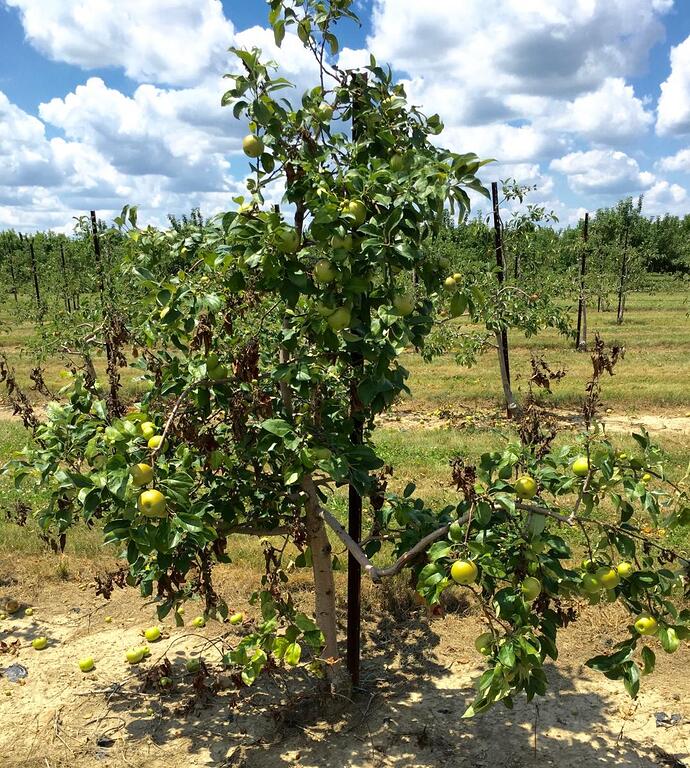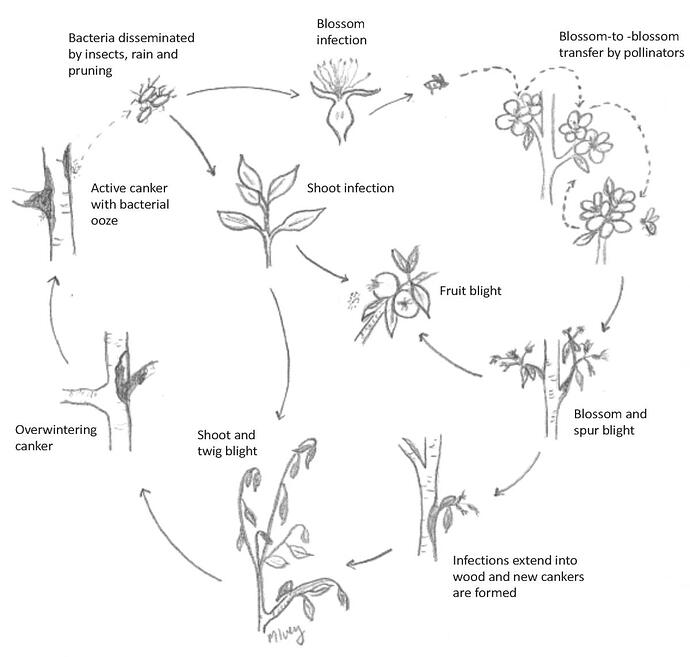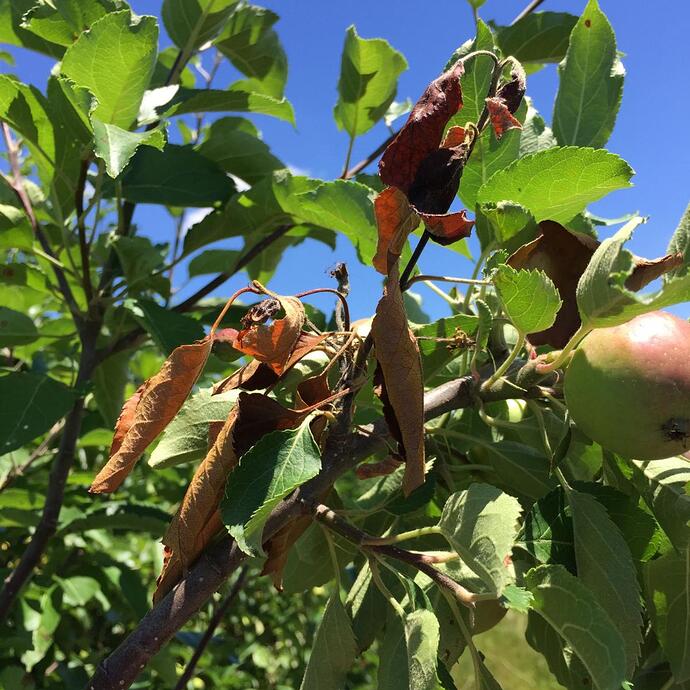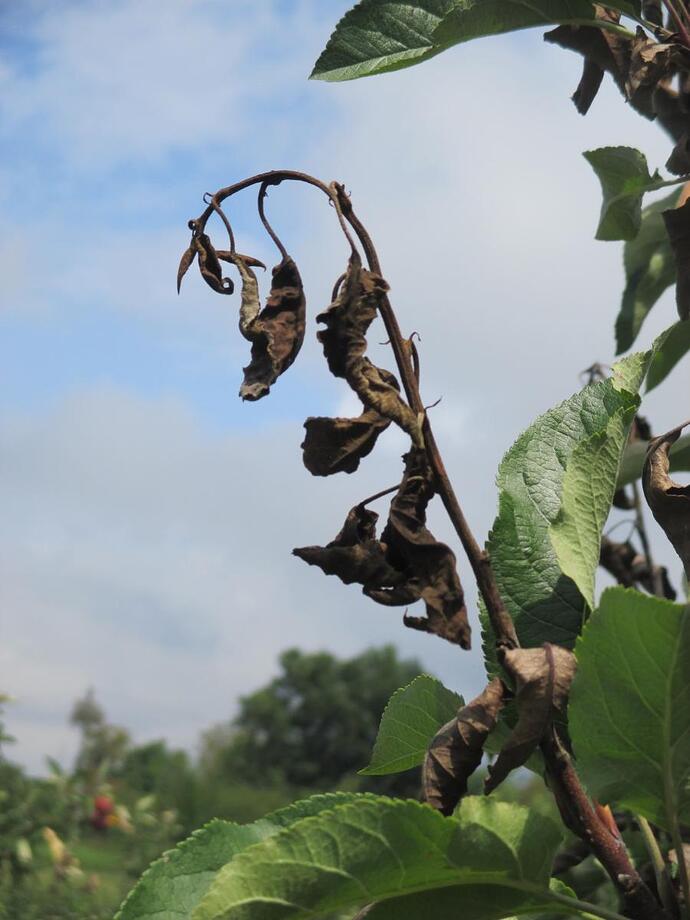Despite spraying copper at the recommended dilution rate with dormant oil this winter, I have signs of blight on my nickel sized Orient & Warren pears. It has not yet spread to my apples. It has been VERY wet this year. I have only been able to spray with Bonide home orchard spray once after blossom fall. I have Spectracide Immunox & Captan in my arsenal. Best program to control?
I certainly do not have nearly the experience in combatting fire blight that others on this forum have. As far as sprays are concerned I seem to get the impression that the streptomycin approach is the most favored. Copper or copper+mancozeb are labeled for fire blight as is Actigard (which I have never used). Perhaps Clark @clarkinks has used it?
In early spring and late fall, kocide 3000 copper is very good against fireblight. Not all copper is equal. Try this method Fire Blight of Apples and Pears | Ohioline
Ohio State University Extension
Menu
Fire Blight of Apples and Pears
Melanie L. Ivey, Assistant Professor, Department of Plant Pathology, The Ohio State University-Ohio Agricultural Research and Development Center, Wooster, OH
Fire blight is a common and very destructive bacterial disease of apples and pears (Figure 1). The disease is caused by the bacterium Erwinia amylovora, which can infect and cause severe damage to many plants in the rose (Rosaceae) family (Table 1). On apples and pears, the disease can kill blossoms, fruit, shoots, twigs, branches and entire trees. While young trees can be killed in a single season, older trees can survive several years, even with continuous dieback.
Figure 1. Fire blight damage on an apple tree.
Table 1. List of commonly grown plants in Ohio that are susceptible to fire blight
Apple
Blackberry
Cotoneaster
Crabapple
Hawthorn Mountain Ash
Pyracantha
Quince
Raspberry
Spirea
DISEASE DEVELOPMENT
Fire blight first appears in the spring when temperatures get above 65 degrees F. Rain, heavy dews and high humidity favor infection. Precise environmental conditions are needed for infection to occur and as a result disease incidence varies considerably from year to year.
Fire blight bacteria overwinter as cankers in living tissue on the trunk and main branches and on mummified fruit. Primary infections (Figure 2) are initiated during bloom when bacteria are carried from the cankers to open flowers by splashing rain, pollinating insects (i.e., bees, pollen wasps, flies, ants) or during production practices such as pruning. Relatively few overwintering cankers become active and produce bacteria in the spring, but a single active canker may produce millions of bacteria, enough to infect an entire orchard. These bacteria multiply rapidly in the blossom nectar, and spread to the spurs (blossom-bearing twigs), new shoots and branches, resulting in secondary infections. Shoot infections can also occur through wounds created by sucking insects (aphids, leafhoppers or tarnished plant bugs), freeze or frost damage, wind whipping, wind-driven rain, or hail. Once a shoot is infected, the fire blight bacteria multiply rapidly and droplets of ooze can be seen within three days. Shoots remain highly susceptible to infection until vegetative growth ceases and the terminal bud is formed.
Figure 2. Fire blight disease cycle.
SYMPTOMS
Figure 3. Fire blight on apple blossoms and spurs.
Fire blight symptoms vary depending on the tissue affected and can also vary between pear and apple.
BLOSSOM AND SPUR BLIGHT
Blossom and spur symptoms appear in the spring. Bacteria gain entry into the tree via blossoms and new shoots. Diseased blossoms become water-soaked, wilt and turn brown. Bacteria spread rapidly into other flowers in the cluster and then move down into the spur. Spurs become blighted, turning brown on apples and black on pear (Figure 3).
SHOOT BLIGHT
Shoot blight starts at the growing tips of shoots and moves rapidly down into older portions of the twig. Blighted twigs first appear water-soaked, then turn dark brown or black. As blighted shoots wilt, the twigs bend at the growing point and resemble a shepherd’s crook or an upside down “J” (Figure 4). Blighted leaves remain attached to the dead branches throughout the summer. During warm and humid weather infected shoots will ooze droplets of creamy white bacteria.
Figure 4. Fire blight on an apple twig. Note the curved “shepherd’s crook” at the tip of the diseased twigs. Image courtesy of Marcus McCartney, OSU Extension, Washington County.
STEM CANKERS
As fire blight bacteria move through blighted twigs into the main branches, the bark sometimes cracks along the margin of the infected area causing a distinct canker (Figure 5). Bark on younger trees becomes water soaked and the cankers have a dark brown to purple color. Sapwood beneath a canker has a reddish brown appearance (Figure 5) and may be soft to the touch. Cankers can girdle the main branches and trunk causing additional dieback.
FRUIT BLIGHT
Both apple and pear fruit may be blighted. Rotted areas turn brown to black and become covered with droplets of whitish tan colored bacterial ooze. Fruit remain firm and eventually dry out and shrivel into mummies.
ROOTSTOCK SYMPTOMS
Fire blight symptoms on rootstocks usually develop near the graft union. Symptoms are similar to those of stem cankers. Fire blight infections in rootstocks can rapidly kill the tree by girdling the rootstock.
MANAGEMENT
Fire blight is one of the most difficult diseases of apple and pear to manage, and no one procedure will give complete control. Though management is not an easy task, the use of several practices in an integrated manner should result in minimal damage and losses from fire blight.
 |
|
|---|---|
| Figure 5. Fire blight cankers on young apple tree trunks (top) and mature tree branch (left). Note the reddish brown appearance of the sapwood beneath the canker on the mature tree branch. |
Commercial growers should consider following a recommended chemical spray program for fire blight.
Chemical sprays for fire blight control are generally not recommended for backyard growers. Instead, backyard growers are encouraged to plant less susceptible varieties and use other nonchemical control measures, some of which are described below.
For the most current spray recommendations, commercial growers are referred to the Midwest Fruit Pest Management Guide. Backyard growers are referred to Bulletin 780, Controlling Diseases and Insects in Home Fruit Plantings, which is available from your county Extension office or the CFAES Publications online bookstore at extensionpubs.osu.edu/.
MANAGEMENT TACTICS FOR FIRE BLIGHT
Select and plant resistant varieties. Planting highly susceptible varieties makes fire blight management extremely difficult. When establishing an orchard, select and plant apple and pear rootstocks (Table 2) and varieties (Table 3) that are less susceptible to fire blight.
Prune out fire blight cankers and blighted twigs. Dormant season (winter) pruning of blighted twigs and cankers removes fire blight bacteria from the orchard so that the bacteria will not be there to start new infections in the spring. Even in orchards without a known history of fire blight, it is important to look for blighted twigs and cankers and remove them. To remove blighted twigs, make a clean cut into healthy tissue that is at least 4 inches below visibly dead wood. Cankers can be cut out of trunks or large branches by removing dead tissue until healthy tissue is observed. Infected plant tissue should be taken out of the orchard and burned or placed into the trash.
Table 2. Level of fire blight resistance in apple and pear rootstocks
S = susceptible, MR = moderately resistant, R = resistant
Apple Rootstocks Resistance Level
Bud.9* S
Bud.118 MR
Geneva 11 R
Geneva 16 R
M.7 R
M.9* S
M.26 S
MM.106 MR
MM.111 MR
Pear Rootstocks
Bartlett seedling S
Old Home (OH) R
Old Home x Farmingdale (except OH x F 51) R
Quince seedling S
*Although Bud.9 and M.9 are susceptible to fire blight, observations in Ohio indicate that Bud.9 is less susceptible to rootstock infection by fire blight bacteria than M.9.
Minimize summer pruning of blighted shoots. Summer pruning of blighted shoots can slow the movement of bacteria in the orchard if done carefully and correctly. However, if proper sanitation practices are not used, bacteria can be inadvertently spread to healthy tissue and exacerbate the disease. Pruning of blighted shoots should only be done in dry weather, cuts should only be made into healthy tissue that is at least 12 to 15 inches below diseased wood, and pruning tools must be sanitized after each cut. Tools can be sanitized by dipping them into a 10 percent bleach solution (1 volume of bleach to 9 volumes of water) containing a few drops of liquid soap. A new bleach solution should be prepared when the solution appears dirty. Infected plant tissue should be taken out of the orchard and burned or placed into the trash.
Follow proper pruning and fertilization practices. Excessive nitrogen fertilizer and heavy pruning will promote vigorous growth of succulent tissue, which is very susceptible to fire blight. Make fertilizer applications in early spring or late fall after growth has ceased. Never conduct routine pruning (i.e., pruning to stimulate growth or shape the tree) at the same time as pruning to remove blighted twigs, shoots or cankers.
Make an early season application of copper. Trees with a history of fire blight should be sprayed with a copper-based pesticide to reduce the build-up of bacteria on buds and bark. Copper should be applied at silver tip (when buds are just beginning to swell) to green tip and no later than half-inch green (Figure 6).
Table 3. Relative susceptibility of common apple and pear cultivars to fire blight
Highly Susceptible Moderately Susceptible Moderately Resistant
Apple
Beacon Dutchess Jonafree
Cortland Empire Melrose
Fuji Golden Delicious Northwestern Greening
Gala Haralson Nova Easygro
Granny Smith Jonagold Prima
Idared Jonamac Priscilla
Jonathan Jerseymac Quinte
Lodi Liberty Red Delicious
Monroe McIntosh Red Free
Mutsu (Crispin) Minjon Sir Prize
Paulared Northern Spy Pristine
Rome Beauty Novamac Liberty
Wayne Spartan Goldrush
Wealthy Honeycrisp Enterprize
Yellow Transparent Braeburn Sundance
Ginger gold Winsap/Staymen strains Williams Pride
Pear
Aurora Maxine Kieffer
Bartlett Seckel Magness
Bosc Beurre D’Anjou Moonglow
Clapp’s Favorite Harrow Delight
Red Bartlett Honeysweet
Reimer Red Blake’s Pride
Starkrimson
Spray streptomycin at bloom. Streptomycin is an antibiotic that can kill fire blight bacteria before they enter the apple tree. The nectaries of the flowers are where bacteria enter apple trees, so it is critical that streptomycin is applied while the flowers are open. For this reason, streptomycin may need to be applied multiple times until petal fall. Streptomycin can also be applied as a rescue treatment following a severe weather event such as hail, wind-driven rain or high winds.
Streptomycin is available to backyard gardeners but is not recommended due to the risk of the bacteria becoming resistant to the antibiotic if it is not used properly. To reduce the risk of antibiotic resistance:
• Use the recommended rate on the streptomycin label
• Make no more than three to four applications per season
• Do not use streptomycin after symptoms have developed
• Do not use streptomycin for shoot blight or canker control
 |
 |
|---|---|
| Figure 6. Apple buds at the silver tip (left) and early green tip stage (right). Images courtesy of Mark Longstroth, Michigan State University Extension and Dave Schmitt, Rutgers Cooperative Extension. |
The biological control product Serenade Garden Defense, which contains beneficial antibiotic-producing bacteria (Bacillus subtilis), can be used by backyard gardeners in place of streptomycin. Like streptomycin, Serenade Garden Defense should be applied to open flowers through bloom.
Apply the plant growth regulator Apogee. Apogee (prohexadione-calcium) is a growth inhibitor that can reduce shoot blight when applied preventatively at 1 to 3 inches of new shoot growth. Apogee will not control blossom or spur blight. Orchards with a history of fire blight or planted with fire blight susceptible varieties or rootstocks will benefit the most from an Apogee treatment. Commercial growers should contact their county Extension educator or fruit tree specialist for guidance on determining if Apogee should be applied in their orchard. Apogee is not recommended for backyard growers.
Control sucking insects. Sucking insects create wounds through which fire blight bacteria can enter. These pests should be controlled throughout the growing season. To protect bees, do not apply insecticides during bloom.
Original author: Michael A. Ellis, Professor Emeritus, Department of Plant Pathology. (Originally published in 2008.)
Topics:
Tags:
Program Area(s):
Originally posted Oct 19, 2016.
PLPATH-FRU-22
Date:
Oct 19, 2016
To print a fact sheet, use the “Print” command in your browser. You may then either print the fact sheet or save it as a PDF. Best printed in Google Chrome.
Social Media
LOCATE AN OFFICE
We connect with people in all stages of life, from young children to older adults. We work with families and children, farmers and businessowners, community leaders and elected officials to build better lives, better businesses and better communities to make Ohio great.
OHIOLINE
College of Food, Agricultural, and Environmental Sciences
2120 Fyffe Road | Room 3 Ag Admin Bldg.
Columbus, Ohio 43210
Phone: 614-292-6181
© 2024 | 2120 Fyffe Road | Room 3 Ag Admin Bldg. | Columbus, Ohio 43210 | 614-292-6181
Accessibility Accommodation
If you have a disability and experience difficulty accessing this content request accommodation here.
Maintenance and Support
This site designed and maintained by CFAES Marketing and Communications. For technical support please contact the CFAES Helpdesk.
CFAES Diversity | Nondiscrimination notice | Site Map
"
Back to your excellent questions
Actigard is price prohibitive for most operations growing pears. There is typically not enough money being made to offset the cost.
“Copper is an effective bactericide and fungicide, commonly used for many fruit tree diseases
and a few vegetable diseases. It is one of a very short list of fungicides available to organic
producers.
However, if used over a long period, copper can accumulate in soils and cause toxicity in
certain crops. It can also contribute to water quality issues. A copper exceedance has occurred in
the PNSSNS Subwatershed, so carefully consider any copper use and choose alternatives
whenever possible.
Alternatives to Copper
Bordeaux mix, which does contain copper, is more persistent than fixed copper materials. It is
less susceptible to being washed off by rain, so it is a better choice for dormant sprays.
However, Bordeaux mixture is corrosive, so a pre-mixed material is the safest. If you plan to
mix your own, please follow the instructions and precautions at http://
www.ipm.ucdavis.edu/PMG/PESTNOTES/pn7481.html
Lime sulfur or sulfur may be other options for organic growers.
Protectant fungicides such as the Strobilurins and Sterol inhibitors are absorbed into leaf and
fruit tissue. Thus, once the residue has dried, they are not susceptible to rain wash-off.
Alternatives for Specific Diseases
Fireblight: Effective copper alternatives are Streptomycin for apples
and pears; Mycoshield or Blight Ban for pears; or Bordeaux mix for
apples.
Brown rot: Copper is not very effective for stone fruits; there are
many Demethylation Inhibitor materials (DMIs) which are more
effective choices. In citrus, prune skirts and use Bordeaux mix or potassium phosphite.
Leaf curl: use Ziram, Bordeaux mix, or Chlorothalonil.
Shothole: use Bordeaux in the dormant season; Ziram or Pristine around bloom. A Bordeaux
spray after leaf fall but before heavy rains reduces spring disease incidence.
Walnut blight: use Bordeaux mix. Use forecast models to time sprays effectively.
Bacterial speck and bacterial spot occur in early plantings of tomato and pepper in wet
springs. Delay planting if possible. Good sanitation, including disking in crop residues and
culls will reduce incidence, as will rotation to non-host crops. Tank mix with copper sprays
with Mancozeb to increase effectiveness. Apply before rainfall. Thorough coverage helps
minimize the number of sprays needed.”
170641.pdf (389.3 KB)
" Actigard 50WG Fungicide
Activating the natural defense systems in several crops, Actigard® 50WG helps the plant to protect itself against attacks from diseases. Actigard is highly effective at low use rates and is an excellent fit in an Integrated Pest Management program.
Active Ingredients:
Acibenzolar-S-methyl
Resistance Management:
Group P01 Fungicide"
The dormant application of copper that I have been using is the ammonia complex of the acetate salt. I don’t have enough experience to say how effective it is or is not vs fire blight. Every thing that I have seen in the few years since my trees have flowered that I looked at said to myself, “that could be fire blight” has been what I think would be called “twig blight”.
This is some of the best advice that goes against most folks desire to fertilize during spring and summer to get the most growth to ‘speed up’ the fruiting process…and get that ‘fast growing tree’ that everyone wants.
Dormant copper sprays are not really going to prevent fireblight. What has worked for me has been spraying streptomycin on the blooms within 24 HR ahead of rain. I think there are some copper products than can be sprayed on the blooms but I think it is different from the dormant kind. There is some data suggesting that the product Blossom Protect also works ok but not as good as strep. That’s about it as far as I know.
So I’m now in the stage where all 3 pears are putting on new growth after late winter pruning and are carrying nickel size pears. Any experience on what works best at this stage?
There is nothing you can spray to kill it because the bacteria entered the plant tissue through the flowers a few weeks ago. Now they spread inside the tree. It will flare up in new growth and fruit clusters when conditions are good. Keep very close eye out for it and prune ahead of any visible symptoms. Actiguard can be sprayed to slow down shoot growth to make them less susceptible to FB moving inside the tree. But i’ve never tried it.
Organic to me is a buzzword in many circumstances. One of them is in using copper.
As Clark shared, copper CAN be extremely toxic for aquatic life and literally to the trees attempting to be protected.
That said, properly applied, it is a fantastic tool in the toolbox and accumulation to the point of toxicity in soils is unlikely when properly managed. But, it does do a good job of killing things, possibly including good things. That is one aspect to be weighed when choosing any spray, not necessarily just copper.
I say that with a significant arsenal of sprays I intend to utilize on an as needed basis myself, but basically more to say do your homework and see if other options might be acceptable for managing diseases and critters.
Does anyone know how long streptomyacycin (Fertilome) lasts in tank sprayer once mixed with water? I havd looked everywhere online including the company’s website and can not find anything other than how to store the powder.
I assume it has to be used the same day after mixing. If not i can save a gallon that I have left from spraying yesterday on my apple trees.
The medical injection version of streptomyacycin says use within 24 hours of mixing ‘if refrigerated’, so I’d guess the answer that you are looking for would be very similar to that, maybe even less time than that since it’s certainly not the same exact product.
I think it should be fine for days/weeks if you keep it out of the heat and sun. I don’t have any direct experience with it in this context, but I’ve worked with it in the lab where it is stable in water-based solutions for at least a few weeks. For long term storage you’d have to freeze it.
I have it in a cool (this time of year) garage. I’d like to be able to use this batch once more later this week. Going forward I will mix more carefully to ensure smaller batches I can use in their entirety.
I had heard before about the suggestion to use the mixture for human use quickly. I am encouraged hearing about the other experience in the lab where it lasts much longer.
So despite planting somewhat resistant pear varieties (Orient & Warren), & spraying copper during winter, I have blight attacking the new growth & nickel size pear stems. I am trimming away the blighted parts with alcohol sanitized shears & disposing of the diseased portions off orchard. I ordered the Ferti-Lome Fire Blight Spray & was disappointed to read that they recommend not using their product once fruit develops. Not sure if not using it is worse than FB spreading to my apples. From you more experienced orchardists, what are my options?





